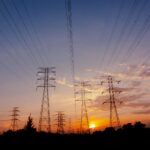Background
Traditional biomass energy, with its adverse impacts on the environment, health and agricultural productivity, is still the mainstay of Nepal’s energy sector. All fossil fuels are imported from India. Nepal spends more on importing petroleum products than it earns from exports[1], posing a serious threat to the national economy and energy security, given the increasing global petroleum prices and geo-political vulnerabilities. Only 5% of Nepal’s economic hydropower potential of about 40 gigawatts has been harnessed. Nepal also receives ample solar radiation for about 300 days a year, but is largely untapped[2].
As of mid-April 2022, Nepal’s total installed electricity generation capacity was 2,191 megawatts[3]. During the fiscal year 2020-21[i], total available electricity was about 8.9 terawatt-hours out of which about 36.5% was from independent power producers and 32% was imported from India[4]. About 44% electricity was consumed by the residential sector, 37% by industries, 7% by commercial establishments and the remaining by the agricultural and other sectors. Electricity losses were about 16% and only 0.7% was exported to India[5]. However, from June 2022, Nepal’s electricity export to India has increased sharply, and is expected to now be a significant percentage of Nepal’s hydroelectric generation. As of mid-March 2021, 93% of the population had electricity access[6] and as of mid-April 2022, the per capita electricity consumption was 325 kilowatt-hours. Electricity to about 972,00 households in remote rural areas is from solar photovoltaic home systems or mini grids[7].
Hydropower development in Nepal until the 1990s was government led and mostly international donor funded. The Electricity Act of 1992 and the subsequent feed-in tariff policy jumpstarted private sector investment in electricity generation[8]. Currently, over a third of the electricity generation is from the private sector, with a huge pipeline of private projects under various stages of development. Nepal has been attempting to reform its electricity sector, especially since the 1990s. Like many other countries attempting such reforms, Nepal has attempted to carry out the “textbook model” of reforms[9], which have moved slowly and faces myriad resistances[10].
Political instability, with frequent changes in political leadership and mostly coalition form of government has adversely impacted electricity development in Nepal because of unstable policies, delays in new policies and weak implementation of policies and reforms [11].
Main Challenges for Nepal’s Energy Sector
Unsustainable Energy Use in Cooking and Transport
Solid biomass fuels and liquid petroleum gas (LPG) are the main cooking fuels in rural and urban Nepal, with LPG rapidly replacing biomass in rural areas. Import of LPG for cooking and petroleum products for transport is rapidly draining Nepal’s foreign currency reserves[12]. Therefore, switching to clean energy sources, especially electricity, for cooking and transport is a huge challenge for Nepal and enabling this fuel switching is an import policy goal of the Government of Nepal[13].
Energy Insecurity
Nepal has multiple challenges that threaten its energy security. Firstly, Nepal is vulnerable to natural disasters like floods, earthquakes and landslides. Secondly, Nepal’s total reliance on imported fossil fuels and electricity imports makes it vulnerable to fuel supply disruptions, as has happened twice in the last 35 years, once in 1989 and recently in 2015 because of economic blockade, when fuel supply was hit the hardest. Therefore, ensuring a continuous supply of adequate, reliable and affordable renewable and clean energy uninterrupted by environmental, geographical, social, political, economic or climatic causes is a major policy goal for Nepal[14].
Providing Electricity Access for All
Providing electricity to all Nepalis is another major policy goal of the Government of Nepal[15]. Consequently, the government has emphasized rural electrification mainly from the national grid, with remote communities outside the reach of the national electricity grid to be supplied by off-grid options like micro hydro and solar photovoltaic systems[16]. However, even in areas where electricity has reached (both urban and rural), poor quality of supply and frequent supply disruptions because of insufficient investment and operational inefficiency still plagues the Nepalese electricity sector[17]. The major policy reform option for this is more infrastructure investments, cost reflective electricity prices and targeted subsidies to low income and marginalized households[18].
Challenges to Hydropower Development in Nepal
Hydropower plays a predominant role in Nepal’s electricity system. Currently, 96.2% of the installed capacity is from hydropower, 3.7% from thermal and 0.1% from solar plants. Only 68% of the 8.8 GWh electricity consumed in Nepal in 2021 was generated domestically, with the remaining 32% imported from India.
However, Nepal’s hydropower sector is faced with the multifaceted challenges ranging from technical, financial, social to environmental[19].
The first challenge is the variability in hydropower generation in Nepal. There is excess electricity during the wet season[ii] and insufficient electricity generation during the dry season, which has resulted in significant electricity import from India. Smoothening Nepal’s electricity generation curve by consuming or selling the surplus electricity during the rainy season and increasing generation during the dry season to reduce imports and also meet Nepal’s rising electricity demand is a major policy challenge facing hydropower development.
To meet Nepal’s growing electricity demand, accelerated development of its hydropower potential is essential. However, it is generally acknowledged that there has been underinvestment in generation. In addition to political and bureaucratic vested interests and inefficiencies, less than attractive electricity prices that are not deemed to be sufficient to support system cost and capital expansion is a major cause of the underinvestment. There is also insufficient investment in infrastructure (roads and transmission lines) crucial for hydropower development[20]. Therefore, another major policy goal for Nepal is to attract investment by introducing efficiency and economic principles into the sector[21].
Nepal’s hydroelectric development is very vulnerable to climate change with significant economic impacts. In recent years, there have been an increase in extreme events, like flooding, high sediment load, landslide-induced dam outburst floods and a few glacial lake outburst floods. A study suggests that there will be a dramatic decline in glacier volumes in the Himalayas, which will drastically reduce the base flow available to hydropower projects, but that there will be more landslides and glacial lake outburst floods[22]. The consequence will be an increase in capital and operational costs, loss of revenue from plant stoppages and increased loss of property and lives. Therefore, increasing the resilience of hydropower plants is another policy goal for Nepal[23].
Nepal’s electricity sector also suffers from some governance challenges. Nepal Electricity Authority, the national electric utility and the sole buyer of electricity, is frequently a victim of political interference. Furthermore, electricity prices and power purchase agreements are many times driven by factors other than scientific or economic principles[24]. Private developers complain about administrative delays in tax refunds and issuance of permits and approvals[25]. Furthermore, the government continues to massively subsidize fossil fuels. Rent seeking, poor economic governance, and inadequately experienced and skilled human resources are other governance failures in the sector[26]. The poor governance and lack of transparency also seen in the private sector has led to further deterioration in the sector governance[27]. Therefore, reform and restructuring of the electricity sector in Nepal is also an urgent policy goal.
Future Prospects of Hydropower in Nepal
Nepal has ambitions to utilize the immense benefits of rapidly harnessing its huge in-country electricity-generating potential. This can range from electric cooking to electric mobility, powering all industrial heating, cooling, and motive power with electricity and electrification of all agricultural related energy needs. Nepal also wants to export its surplus electricity to earn foreign currency and provide environmental services to other South Asian countries[28]. A study has estimated that if Nepal can develop even 20% of its economically feasible potential of about 40,000 megawatts, it can increase its gross domestic product by 87% above the baseline scenario. Furthermore, export of electricity to India could help avoid about 224,000 tonnes of carbon-dioxide per day[29].
However, Nepal will need to take some key steps to realize this ambition.
Firstly, Nepal needs to diversify its electricity generation mix to smoothen its electricity generation curve. Developing pumped storage hydropower projects (with less negative environmental and social impacts), piloting grid scale battery storage systems[30], and operationalizing energy trading has become urgent needs of the Nepalese electricity sector[31]. India is the most feasible energy trade partner for Nepal[32]. In fact, Nepal is negotiating with India to establish a system of “power banking”, where Nepal exports surplus electricity to India when demand is low in Nepal and imports the same volume of power when demand is high[33]. Furthermore, development of Nepal’s immense solar potential to complement hydroelectricity generation by generating electricity during the dry season, when water flow decreases but the solar radiation is high[34]. In addition, policies to promote demand response to match electricity production will be crucial. These include promoting electricity for cooking, transport, industrial and agricultural purposes[35]. This will help to match demand and supply at crucial times of the day or seasons and can be done through pricing and other incentives[36].
Secondly, Nepal will have to build disaster and climate change resilience into its electricity generation system. This may include retrofitting of operating plants, climate smart design of new plants, better hydrometeorological data collection, real-time sediment monitoring and management, early warning systems, flood risk assessments and insurance[37].Use of digital technologies will be very important both for ensuring a seamless integration of various technologies in Nepal’s electricity generation mix, transmission and distribution and also for making the system smart, more efficient and resilient[38].
Thirdly, it has to work further on reforming the governance of the sector. Economic logic and equity considerations need to override personal and vested interests. For independent and effective regulation of the sector, the autonomy and role of the Electricity Regulatory Commission needs to be enhanced. In addition, pricing reforms will be very important[39]. Unbundling of electricity generation, transmission and distribution and their eventual privatization along with strong regulation has to be expedited[40]. However, there has to be a strong political will, without vested interests, to carry out these reforms and ensure they have a lasting impact[41].
If Nepal is to tap into the regional electricity market, another important effort will have to be in reducing cost of generation.
With present cost structures, Nepal’s hydroelectricity may not be attractive since electricity generation costs in Nepal are higher than that in India and Bangladesh[42].
To conclude, Nepal’s hydropower will continue to be a blessing for Nepal if we can take the appropriate and timely actions related to technology, institutions and policies to have a balanced and sustainable electricity generation mix, a system resilient to disasters and climate change and governance that focuses equally on efficiency and equity.
[This essay is based on an essay written by the author for his MSc in Energy Policy course]
…
[i] The Nepali fiscal year extends from mid-July to mid-July.
[ii] From June till October, which is monsoon season.
[1] MOF, “Economic Survey – Fiscal Year 2020/21,” Government of Nepal, Ministry of Finance (MOF), Kathmandu, 2021.
[2] R. Nepal and T. Jamasb, “Reforming small electricity systems under political instability: The case of Nepal,” Energy Policy, vol. 40, pp. 242-251, 2012.
[3] MOEWRI, “Ministerial Report on its Activities (as per Right to Information Laws of Nepal),” Government of Nepal, Ministry of Energy, Water Resources and Irrigation (MOEWRI), Kathmandu, 2022.
[4] NEA, “A Year in Review – Fiscal Year 2020/21,” Nepal Electricity Authority (NEA), Kathmandu, 2021.
[5] MOF, “Economic Survey – Fiscal Year 2020/21,” Government of Nepal, Ministry of Finance (MOF), Kathmandu, 2021.
[6] Ibid
[7] MOEWRI, “Ministerial Report on its Activities (as per Right to Information Laws of Nepal),” Government of Nepal, Ministry of Energy, Water Resources and Irrigation (MOEWRI), Kathmandu, 2022.
[8] K. Pandey, “Three Decades of Private Investment in Electricity,” Urja Khabar, 31 May 2022. [Online]. Available: https://urjakhabar.com/news/3105959880. [Accessed 7 June 2022].
[9] T. Jamasb, R. Nepal and G. R. Timilsina, “A Quarter Century Effort Yet to Come of Age: A Survey of Electricity Sector Reform in Developing Countries,” The Energy Journal, vol. 38, no. 3, pp. 195-234, 2017.
[10] Ibid; P. L. Joskow, “Lessons Learned From Electricity Market Liberalization,” The Energy Journal, vol. 29, no. Special Issue 2, pp. 9-42, 2008
[11] R. Nepal and T. Jamasb, “Reforming small electricity systems under political instability: The case of Nepal,” Energy Policy, vol. 40, pp. 242-251, 2012.
[12] MOFE, “Assessment of Electric Cooking Targets for Nepal’s 2020 Nationally Determined Contributions (NDC),” Government of Nepal, Ministry of Forests and Environment (MOFE), Kathmandu, 2021.
[13] NPC, “The Fifteenth Plan (Fiscal Year 2019/20 – 2023/24),” Government of Nepal, National Planning Commission (NPC), Kathmandu, 2020.
[14] MOF, “Nepal’s Budget for the Fiscal Year 2022-2023,” Government of Nepal, Ministry of Finance (MOF), Kathmandu, 2022.
[15] Ibid
[16] R. Nepal and T. Jamasb, “Reforming small electricity systems under political instability: The case of Nepal,” Energy Policy, vol. 40, pp. 242-251, 2012.
[17] Ibid
[18] Ibid
[19] K. Pandey, “Three Decades of Private Investment in Electricity,” Urja Khabar, 31 May 2022. [Online]. Available: https://urjakhabar.com/news/3105959880. [Accessed 7 June 2022].
[20] “The Way Forward for Nepal’s Hydropower Development,” Hydro Review, 1 November 2019. [Online]. Available: https://www.hydroreview.com/world-regions/hydro-review-the-way-forward-for-nepal-s-hydropower-development/#gref. [Accessed 8 June 2022].; 2022. Pandey, “Three Decades of Private Investment in Electricity,” Urja Khabar, 31 May 2022. [Online]. Available: https://urjakhabar.com/news/3105959880. [Accessed 7 June 2022].
[21] R. Nepal and T. Jamasb, “Reforming small electricity systems under political instability: The case of Nepal,” Energy Policy, vol. 40, pp. 242-251, 2012.
[22] A. Dixit, “Climate risk to hydropower investment,” Nepali Times, 22 March 2019. [Online]. Available: https://www.nepalitimes.com/opinion/climate-risk-to-hydropower-investment/. [Accessed 5 June 2022].
[23] D. B. Basnyat and P. Watkiss, “Adaptation to Climate Change in the Hydroelectricity Sector in Nepal – Policy Brief,” Practical Action Consulting and Global Climate Adaptation Partnership, 2017.
[24] R. Nepal and T. Jamasb, “Reforming small electricity systems under political instability: The case of Nepal,” Energy Policy, vol. 40, pp. 242-251, 2012.
[25] K. Pandey, “Three Decades of Private Investment in Electricity,” Urja Khabar, 31 May 2022. [Online]. Available: https://urjakhabar.com/news/3105959880. [Accessed 7 June 2022].
[26] R. Nepal and T. Jamasb, “Reforming small electricity systems under political instability: The case of Nepal,” Energy Policy, vol. 40, pp. 242-251, 2012.
[27] K. Pandey, “Three Decades of Private Investment in Electricity,” Urja Khabar, 31 May 2022. [Online]. Available: https://urjakhabar.com/news/3105959880. [Accessed 7 June 2022].
[28] S. Basnet, “Can Nepal Go All Electric?,” Nepal Economic Forum, 11 August 2021. [Online]. Available: https://nepaleconomicforum.org/uncategorised/can-nepal-go-all-electric/. [Accessed 8 June 2022].; 2020. Gunatilake, P. Wijayatunga and D. Roland-Holst, “Hydropower Development and Economic Growth in Nepal,” Asian Development Bank, Manila, 2020.
[29] H. Gunatilake, P. Wijayatunga and D. Roland-Holst, “Hydropower Development and Economic Growth in Nepal,” Asian Development Bank, Manila, 2020.
[30] B. Subedi, “NEA mulling to install battery storage system,” The Kathmandu Post, 11 5 2018.
[31] D. Bhattarai, “Opinion: Who will buy Nepal’s hydropower?,” The Third Pole, 9 April 2019. [Online]. Available: https://www.thethirdpole.net/en/regional-cooperation/nepals-hydropower/. [Accessed 2022 June 5].
[32] R. Nepal and T. Jamasb, “Reforming small electricity systems under political instability: The case of Nepal,” Energy Policy, vol. 40, pp. 242-251, 2012.
[33] “The Way Forward for Nepal’s Hydropower Development,” Hydro Review, 1 November 2019. [Online]. Available: https://www.hydroreview.com/world-regions/hydro-review-the-way-forward-for-nepal-s-hydropower-development/#gref. [Accessed 8 June 2022].
[34] S. P. Lohani and A. Blakers, “100% renewable energy with pumped-hydro-energy storage in Nepal,” Clean Energy, vol. 5, no. 2, pp. 243-253, 2021.
[35] P. Golyan, “Markets for Electricity in Nepal,” Urja Khabar, 1 June 2022. [Online]. Available: https://www.urjakhabar.com/news/0106529862. [Accessed 7 June 2022].
[36] WEF, “The Future of Electricity – New Technologies Transforming the Grid Edge,” World Economic Forum (WEF), Geneva, 2017.
[37] D. B. Basnyat and P. Watkiss, “Adaptation to Climate Change in the Hydroelectricity Sector in Nepal – Policy Brief,” Practical Action Consulting and Global Climate Adaptation Partnership, 2017.
[38] IEA, “Digitization & Energy,” International Energy Agency (IEA), Paris, 2017
[39] T. Jamasb, R. Nepal and G. R. Timilsina, “A Quarter Century Effort Yet to Come of Age: A Survey of Electricity Sector Reform in Developing Countries,” The Energy Journal, vol. 38, no. 3, pp. 195-234, 2017.
[40] R. Nepal and T. Jamasb, “Reforming small electricity systems under political instability: The case of Nepal,” Energy Policy, vol. 40, pp. 242-251, 2012.
[41] P. L. Joskow, “Lessons Learned From Electricity Market Liberalization,” The Energy Journal, vol. 29, no. Special Issue 2, pp. 9-42, 2008.
[42] D. Bhattarai, “Opinion: Who will buy Nepal’s hydropower?,” The Third Pole, 9 April 2019. [Online]. Available: https://www.thethirdpole.net/en/regional-cooperation/nepals-hydropower/. [Accessed 2022 June 5].
Suman Basnet is a renewable energy and management professional with over 33 years of experience in project design, assessment, situation analysis, research, capacity building, and facilitation of renewable energy projects in Nepal. Suman is a Senior Distinguished Fellow at Nepal Economic Forum and the Technical lead of Renewable Energy Center, an incubation program under Nepal Economic Forum that aims to be the premier platform for mainstreaming renewable energy issues by engaging multiple stakeholders to articulate discourse that will shape national-level energy policies.





